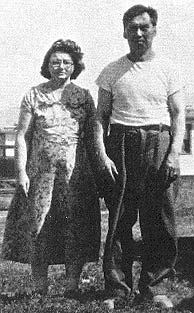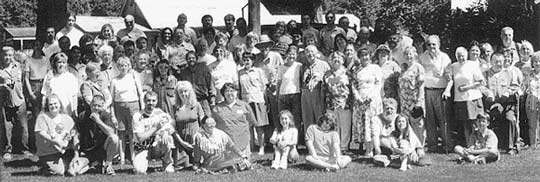|

Poulsbo,
Washington - 1940
Balto Sisters
(l-r) Sophie, Ellen, Mary, and Anna

Anchorage,
Alaska - 1950
Former herders Anna Spein Twitchell (Sami) and Tim Twitchell (Yup'ik)
|
1935:
On February 25, "The Great Trek" finally arrives at the reindeer station
on the Mackenzie River Delta in Kittigazuit, NW Territories with 2,382
reindeer. Baer returns to Seattle where "Andy Baer Day" is declared
in honor of his feat. He is nicknamed "The Arctic Moses."
More
Alaska Sami retire from reindeer work and move south to the Kitsap Peninsula,
Washington. The Tornensis, Baer, Haetta and other families settle in
the townships of Poulsbo, Kingston and Eglon. Some establish chicken
farms and sell their produce in Seattle markets, while others survive
by fishing. Alfred Nilimaa and his wife Marit Pentho make a fortune
and move back to Kautokeino, where they buy a hotel. Others marry into
Inuit, Yupik and white families and remain in Alaska and Canada.
1937:
"The Reindeer Act" places the management of the Alaska herds under the
jurisdiction of the Bureau of Indian Affairs, legally transferring ownership
of all reindeer to Native Alaskans. The model for this development is
the Swedish and Norwegian government policies toward the Native Sami,
who have exclusive rights to own and work with reindeer there. The Alaska
Sami are forced to sell their reindeer for three and four dollars a
head. They feel the US government has betrayed them and more leave for
the Kitsap Peninsula.
1939:
All reindeer not owned by Inuit are rounded up. Many escape and become
part of wild caribou herds. The reindeer owned by Lomen and Company
are bought by the US government for a lump sum of $720,000.
The
Alaska reindeer industry declines for several reasons. The year-round
management required by reindeer means ignoring hunting, fishing and
trapping cycles, the US government does not allow the Inuit to kill
reindeer for their own use or to sell any except the steers, and competition
for grazing areas and the mixing of herds creates confusion.
1947:
After World War II herding is re-established on the Seward Peninsula
by the US government and experienced Native herders are put in charge.
1950: There are 25,000 reindeer in Alaska.
1950:
There are 25,000 reindeer in Alaska.
1959:
Alaska is admitted to the Union as the 49th state.
The
jursidiction of the Canadian Reindeer Project is transferred to the
Canadian Wildlife Service, establishing seven large herds, but there
is little direct management by the 66 Native herders.
1971:
The Alaska Native Claims Settlement Act is passed, legalizing
Native land claims to Indigenous village sites and the right to traditional
ways of life.
1974:
Silas Kanagegana purchases Canadian reindeer. Together with another
Inuit, William Nasogaluak, and business advisor Douglas Billingsley,
Kanagegana forms Canadian Reindeer Ltd. which soon grows into a million
dollar industry.
1975:
There are 30,000 reindeer in Alaska, mostly on the Seward Peninsula,
and Unalaska and Nunivak Islands.
1977:
There are fifteen large herds on the Seward Peninsula alone.
1980:
A Swedish film crew comes to Alaska and interviews Clement
Sara in Bethel, AK. Clement, who came as a child with the
Manitoba Expedition in 1898, passes on in 1983, at the age of 88.
1987:
Nasogaluak's herd grows to 8,000.
1992:
Jos. Kalvemo and a film crew from NRK Sami Radio in Karasjok begins
work on the documentary The Sami in Alaska, filming in Karasjok, Kautokeino,
Alta, Seattle and Poulsbo, WA, Bethel, AK and Kotzebue Sound.
1993:
The finished documentary debuts on Norwegian national television.
1997:
A court ruling allows non-Native Alaskans to own reindeer.
1998:
The centennial reunion for the descendants of the Alaska Sami families
is held in Poulsbo, Washington in June coordinated by Norma Hansen from
Poulsbo, Washington, Bill Wilcox from Port Angeles and Jan Henrik Keskitalo
from Kautokeino, Sápmi. Eighteen from Kautokeino and Karasjok attend,
along with 150 relatives and friends from Alaska and the "Lower Forty-eight."
Kalvemo's video "The Sami in Alaska" is screened. Poulsbo
becomes the sister city of Kautokeino and flags of the US and Sápmi
are exchanged in a ceremony in the town square.
|


![]()


![]()